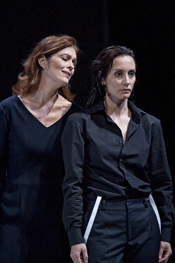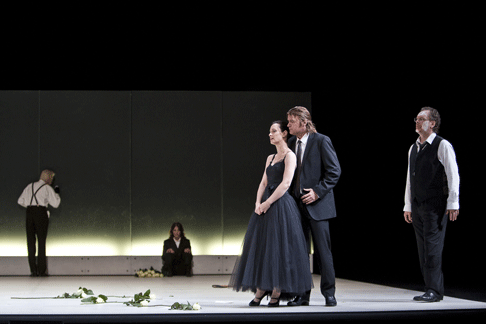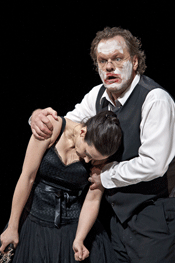07 Jun 2009
A shockingly different Lulu at the Royal Opera House, London
The buzz was right — this new Lulu at the Royal Opera House, London is shockingly different. Christof Loy's production is what minimalism should be.

The buzz was right — this new Lulu at the Royal Opera House, London is shockingly different. Christof Loy's production is what minimalism should be.
Pared down to essentials, all attention is on the music. The stage is almost empty, no props, no furnishings. At first you think, why stage this at all, then? Why not just a concert performance? But gradually it dawns that the “empty” space isn’t empty at all but inhabited by the music, uncompromising and unadorned. That’s why it’s so disturbing. Without décor to cushion the narrative, it’s impossible to escape.
The word “concept” is sneered at in our anti-intellectual world, but without intellect we are no more than beasts. Berg was an extremely conceptual composer. Lulu is constructed like a complex maze, with mathematical symmetries and interrelationships. Berg was obsessed by secret codes and numerology, with patterns and images shifting as if in a kaleidoscope. Berg is doing much more than telling a story in sound. He’s creating a whole new concept, where ideas are expressed through abstraction. He’s not literal, so this very non-literal production reveals just how radical his ideas could be.
The stage is bare but for a wall of glass. Like the glass, Lulu is opaque, impenetrable. Like Lulu, the glass takes on whatever role is projected onto it, whether the scene takes place in a mansion, prison or slum. The glass is Lulu’s mirror image. No wonder there’s no need for a painted portrait. The glass is staring us in the face.
Although the designs look sleek and sophisticated, danger lurks beneath the surface. Twice the narrative is interrupted by news of a revolution in Paris. Then the Third Act takes place in Paris. Everything’s askew like The Cabinet of Dr Caligari where you don’t know who the madman is, doctor or patient. So there’s no film sequence in this production. It “is” the essence of film, and of the opera, and it’s even in black and white.
 Jennifer Larmore as Countess Geschwitz and Agneta Eichenholz as Lulu
Jennifer Larmore as Countess Geschwitz and Agneta Eichenholz as Lulu
The Caligari reference is relevant for throughout this opera people are becoming what they are not, pretending to be someone else, reappearing in different forms. It’s in the music too, with its intricate constructions. So the Professor of Medicine sits with his back to the audience as Lulu fools around with the painter, has his heart attack then rises discreetly from the dead and walks off to become theatre manager and banker. The Painter doesn’t have to commit suicide “convincingly” because he comes back as The Negro. Berg isn’t being naturalistic, he’s playing games of patterns and subterfuge. If Loy’s production is confusing, that’s because the opera is about confusion.
This is not “Lulu for Beginners”, though, conversely, if it’s taken entirely on its own terms, without assumptions of what opera “should” be, it might even be easier to grasp the concept of Lulu as a musical puzzle The first time I saw Lulu was 1978 - the original of the 3 act version - and was so shocked by the passive anti-drama of Lulu’s personality that I didn’t realize that this was exactly what Berg wanted to do. Here, Loy has taken away the obvious signposts to narrative, so we’re forced, like Lulu, to be constantly alert, always aware that things may not be what they seem, and be prepared to shift and adjust. We are drawn into the jungle of shadowy dangers: hence the references to Africa (unknown territory), to snakes and predatory men. It’s a far deeper insight into Lulu’s background than the basic assumption that she was abused as a child. Loy’s implication is that the whole world’s a place where people are forced to play tricks to survive, like the Animal Trainer’s charges.
No doubt there’ll be huge opposition to this Lulu but it’s one that will keep generating ideas for a long time to come. Spartan as it is, each detail is significant. For example, when Dr Schön embraces Lulu, his arms go round her, but his palms are stretched outward. When he starts to disintegrate emotionally in Act Two, there’s a smudge of greasepaint on one side of his face. Lulu had worn such makeup when she was a dancer, and he is a man about to marry someone else. Now he’s the vulnerable one. These details are fleeting, easily missed and may mean different things, so repeated visits to this Lulu are in order.
 A scene from Lulu
A scene from Lulu
Indeed, the full impact of this production may not emerge until long after it’s over. Since coming away from it, I’ve been thinking about Berg’s obsessive sense of order. If the world is in perpetual, confusing chaos, then compulsive orderliness is a means of staving off danger. Berg’s symmetries and palindromes aren’t simply pattern making but a kind of secret incantation. Was he on the verge of something really radical when he died? We shall never know but it’s stimulating to wonder.
 Agneta Eichenholz as Lulu and Michael Volle as Dr Schön
Agneta Eichenholz as Lulu and Michael Volle as Dr Schön
Because this production throws so much emphasis on the music, it’s quite a surprise at first how soft edged the orchestra sounded. Because Boulez is so exceptional, I have to adjust to anyone else. In rehearsals, Antonio Pappano has emphasized the Viennese aspects of this opera, and its submerged romanticism. Submerged, like Lulu’s tragedy. Despite the violence in this opera, it’s tender and dignified. So I can see where the soft focus is coming from. It acts like a counterbalance to the stark sharpness of the staging: Boulez conducting a production like this would be almost too intense to bear.
Agneta Eichenholz was Lulu. She’s quite experienced though mainly in Sweden, which is perhaps appropriate for a Lulu, whose background is unknown. A First Night at Covent Garden was perhaps the highest profile she’s ever had, so if she sounded tense, it’s completely understandable.. It’s a difficult part to sing, and to some extent shrillness fits in with the character. She doesn’t quite have the hypnotizing presence of Christine Schäfer, but it really is asking too much of anyone to expect such standards.
Michael Volle’s Dr Schön is a benchmark realization, all the more impressive because it’s his first time in the role, though he sang Wozzeck only a few months ago. This is Dr Schön’s tragedy as much as Lulu’s. He’s a man who showed compassion when he took Lulu off the streets, even if he may have got something back for doing so. Lulu clearly loves him, though she’s incapable of giving him the same kindness. Because Volle’s Dr Schön looks vigorous and in his prime, his disintegration is all the more distressing. He embodies Berg’s theme of control and chaos: an authoritative, powerful voice but the actorly skills to transit from magnate to tortured soul.
Paradoxically - Lulu is full of paradoxes - the most unrealistic scene in the opera occurs when Countess Geschwitz and Lulu swap clothes and personalities. That couldn’t happen in real life but in Loy’s production the two women really do look alike. Jennifer Larmore’s Countess Geschwitz is also a far more sympathetic portrayal than the butch Cruella DeVille some assume gay people must be. Berg’s sister Smagarda was lesbian, so he knew they were people just like anyone else. Again, this production captures the essence of the opera by not giving the game away with obvious clues. You have to concentrate when Larmore and Eichenholz aren’t singing to keep track of which is which.
Sturdy performances from Klaus Florian Vogt as Alwa and Peter Rose as the Animal Trainer/Athlete. Schigolch, though, might have needed greater definition. Unlike the other characters, he stays the same. He’s the animal who can’t be tamed, and a counter to Lulu herself, so more should have been made of the role. Gywnne Howell sang well, but the wild edge to the part wasn’t present.
Get to this production. Chances are it won’t be seen too often as it’s hardly box office candy. Some ladies sitting near me were day trippers from the country on a package tour of the capital. They must have wondered what hit them.
Anne Ozorio